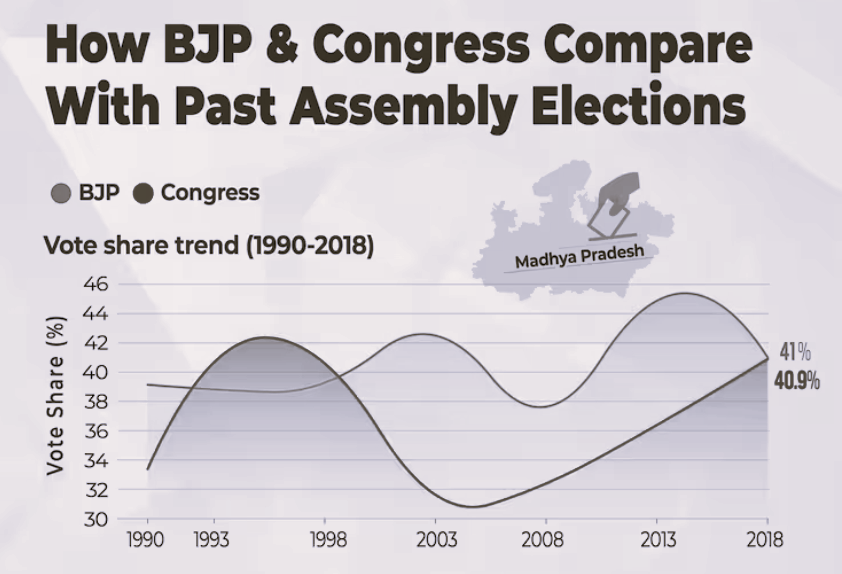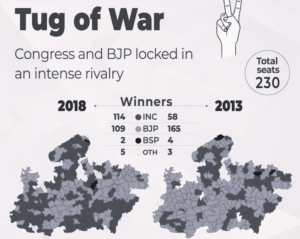
The assembly elections in Madhya Pradesh is one of several pivotal events on the horizon in the upcoming assembly election cycle that will begin in November. The Congress had on Sunday released its first list of 144 candidates for the state. With this, the Congress has declared all but one candidate for elections to the 230-member assembly in Madhya Pradesh.

The Congress replaced its candidate for the Datia assembly constituency, fielding Rajendra Bharti in place of Avadesh Nayak. He will contest against BJP candidate and Home Minister Narottam Mishra. Bharti, a former MLA, had defeated Mishra in the past but lost the last election by a slender margin. The party also fielded Ravinder Singh Tomar from the Dimani assembly seat and he will contest against Union Agriculture Minister Narendra Singh Tomar.
From the Gwalior assembly seat, considered the bastion of Union minister Jyotiraditya Scindia, the Congress has fielded Sunil Sharma, who had unsuccessfully contested in a bypoll against sitting MLA and minister Pradhuman Singh Tomar, a known Scindia loyalist. Pradhuman Singh Tomar had switched over to the BJP along with Scindia after the last assembly polls.
In order to gain a comprehensive understanding of what lies ahead in these elections, a data intelligence unit analysed the state assembly’s election data from 1962 to 2018. The data revealed intriguing patterns in the victory margins over the years. Tight races highlighted the power of grassroots efforts, while big wins stressed guarding strongholds and targeting swing areas.
With specific regard to tight races, it was found that 24% of seats had margins of less than five percent. This means that a mere whisker decided the outcome of every fourth seat. On the other hand, in terms of clear wins, only one in eight seats witnessed victories of over 30 percent, indicating the presence of strongholds. There was also a middle ground, where one in three seats fell within the 5-15% margin. These were highly competitive races but with leads that were nonetheless clearly established.
As Madhya Pradesh gears up for another electoral showdown by the end of this year, the historical patterns suggest a strong political undercurrent in the state. The result could serve as a crucial indicator for national politics.
Over the last six decades, the political terrain in Madhya Pradesh has undergone significant transformations.
The period from 1962 to 1985 marked the dominance of the Indian National Congress in Madhya Pradesh. Data reveals that in 1962, 1967, and 1972, the party secured a broad range of victories, from razor-thin margins to substantial leads.
Frequently establishing itself as the prevailing authority with a substantial majority, the party became closely associated with governing the state. Nevertheless, as the 1980s approached, the party’s prominence began to diminish, marking the onset of a decline in its complete dominance.
In 1967, the Bharatiya Jana Sangh emerged as a significant player, eventually evolving into the contemporary Bharatiya Janata Party (BJP). While the Congress continued to maintain its stronghold for an additional decade, the foundation for an alternative political force was laid during this time.
Around 1977, there was a shift in political dynamics. The Janata Party assumed a prominent position, echoing a nationwide sentiment against the Congress, which had recently imposed and subsequently lifted a state of emergency in the country. Nevertheless, this shift was temporary, as the Congress regained power by 1980.
The BJP began to assert its influence in the 1980s, and as we progress through the years on the heatmap, the saffron shade becomes notably more pronounced, particularly during the 1990s and 2000s. Remarkably, the party exhibited a proficiency in securing victories with significant margins, as evident from the clustering of warmer colours in the “20 to 30%” and “30% and above” categories. By 1990, they had not only arrived on the scene but had established dominance, winning 220 out of 320 seats and heralding a new era in the state’s political landscape. It’s important to note that prior to the separation of Chhattisgarh, Madhya Pradesh had 320 assembly seats.
Since 2003, the Congress faced challenges in Madhya Pradesh, losing thrice—in 2003, the BJP won big with 173 seats; Congress got only 38. The 21st century has been a precarious balancing act, with both parties experiencing peaks and valleys.
The BJP’s dominance in the 2003 and 2013 elections was evident, but the Congress’s resurgence in 2018 suggests a state open to change its course. With narrow margins and high stakes, the forthcoming elections could swing in either direction.
While both parties have witnessed their fair share of nail-biting conclusions, the BJP seems to have a greater number of seats with clear-cut victory margins, particularly in the 10 to 15% and five to 10% ranges. On the flip side, the Congress holds a slight advantage in the most tightly contested seats (with less than a 5% margin).